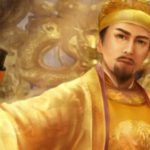The Majesty of the Emperor
Lý Càn Đức, commonly known as Lý Nhân Tông, was the son of Lý Thánh Tông and Queen Ỷ Lan, born on January 25th, 1066. Lý Thánh Tông was a revered king with great governance and a love for the people. Despite having many concubines, he only had daughters and no sons.
Historical records state that in 1063, when Lý Thánh Tông was 40 years old, he met Ỷ Lan – a beautiful and intelligent girl picking mulberries under a lan tree during a festival, and later brought her into the palace. Today, the area where this story took place is still honored at the Bà Tấm Temple in Dương Xá commune, Gia Lâm district, Hanoi.
According to the “Complete Book of Đại Việt Chronicles,” Lý Thánh Tông sent officials to pray all around for a son. A notable event occurred at the Holy Lord’s Pagoda, now located in Dịch Vọng Hậu ward, Cầu Giấy district, Hanoi, when Nguyễn Bông, a courtier, was sent to pray and later killed due to a matter related to fetal positioning.

In the work “Historical Records of the Lý Dynasty,” there is a detailed description of Lady Ỷ Lan’s pregnancy and the birth of Lý Càn Đức after an incident involving Nguyễn Bông and a monk at the Holy Lord’s Pagoda.
A dream of Lý Thánh Tông gifting him a baby boy, recorded in the “Chronicle of Đại Việt,” marked the birth of Lý Càn Đức. Immediately after birth, Lý Càn Đức was proclaimed the Crown Prince and inherited the throne at the age of 7 under the name Lý Nhân Tông. Historical records also noted his distinctive appearance, with a high forehead and arms reaching below his knees, an image believed to be fitting for an Emperor.
The Talented Young King
Despite his young age and dependence on his mother, Lý Nhân Tông quickly displayed his intelligence and skill in governing the country. He also had the support of talented individuals like Lý Đạo Thành in administrative affairs and Lý Thường Kiệt in military matters, making Đại Việt increasingly powerful.
In terms of governance, Lý Nhân Tông established a hierarchical system with 9 ranks, laying a solid foundation for the bureaucratic system. He paid special attention to agricultural development, advocating for the construction of irrigation systems such as the modern Cơ Xá dike near Long Biên bridge, which laid the foundation for flood prevention in Vietnam and protected the capital city.

In 1117, Lý Nhân Tông issued a strict decree banning the killing of water buffaloes. Buffalo theft was also heavily punished and required compensation; even neighbors who did not report were penalized.
In terms of education, he initiated the triennial examinations to select talents and established the Quốc Tử Giám, the first university in Đại Việt, which gathered outstanding scholars.
Lý Nhân Tông also demonstrated military prowess by discussing strategies with his officials to deal with the invading Song Dynasty since childhood. He and Lý Thường Kiệt successfully repelled the Song invasion on the Như Nguyệt River in 1076. Lý Nhân Tông also proved to be a skilled diplomat, negotiating the return of the Vật Dương and Vật Ác caves from the Song Dynasty.
Lý Nhân Tông regarded Buddhism as the state religion, using it as a tool to unify people’s hearts and strengthen the royal position. He showed strong patronage for Buddhism, from organization and development to the improvement of doctrines.

The king sent envoys to the Song Dynasty twice to request Buddhist scriptures and appointed Khô Đầu as the National Master. He also took care of categorizing and managing temples, especially in renovating the Diên Hựu Pagoda, making it a significant historical site.
Lý Nhân Tông also organized numerous boat racing festivals and grand events such as the Quảng Chiếu lantern festival, showcasing the magnificence of the dynasty.
Historians from Lê Văn Hưu to Lê Quý Đôn highly regarded his leadership abilities. “The Complete Book of Đại Việt Chronicles” describes his reign as a period when other countries respected and feared Đại Việt, with wealthy and peaceful citizens.
Lý Nhân Tông passed away in 1127 after a 55-year reign, leaving behind a testament of “Lâm chung di chiếu,” reflecting the benevolence and humility of a king who did not want to burden the people, even in his final moments.
































